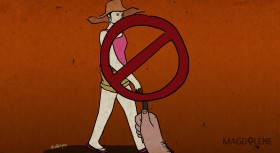T-shirt company Threadless (www.threadless.com), is known as a successful online business model that prints its t-shirts based on designs chosen by their members all over the world. If the print is in high-demand, the Chicago-based company will reprint the design, this time, not only on t-shirt, but also a plethora of products that range from messenger bags to shower curtains, aprons and umbrellas. Threadless t-shirts are so popular (I found at least two t-shirt stores in Chatuchak market and Khaosan Road in Bangkok that exclusively sell Threadless’ knock-offs) that its community-based business model has been replicated by many online stores, including Indonesia’s own www.gantibaju.co.
Each year, Threadless names a t-shirt designer as the recipient of their prestigious Designer of the Year award. And this year’s award goes to the 28-year-old Indonesian graphic designer named Budi Satria Kwan from Makassar, South Sulawesi.
According to Threadless’ blog, for the past seven years, Budi’s designs have been printed 70 times, and a total of 268,490 products have been sold to buyers in 141 different countries . He has also established his own online t-shirt stores www.concreterocket.com/cr/. In a recent email interview, the talented designer talks about his success and how Indonesian graphic designers have reached global fame, but not for their creations.
When did you start designing t-shirt?
I started drawing using digital media about nine years ago, when I bought my first computer. I just love to draw since I was a kid.
What kind of graphic design that you like?
I love minimalist design, but sometimes I play with colors too. I often created surreal designs. My designs are actually drawn from my interests, objects that I found interesting or amusing in my day-to-day activities, such as popular culture.
If my works must be categorized, then they will fall into contemporary style, because contemporary covers a wide variety of design styles, and so are the themes of my designs.
How did you learn about Threadless?
I found out about Threadless while I was randomly searching for images with Google.
How did you first submit your design to Threadless?
Threadless is one of the reasons behind my decision to start drawing digitally. I was over the moon when I found they would print my design. My first print was in 2006, I received a cash prize of $2000 and $500 worth of Threadless shopping certificates with which I bought a bunch of t-shirts.
Your designs have been printed in more than 268 thousands sold items. Why do you think people love your designs?
I can never be sure about it. However, prior to printing, these designs were put on voting to test how receptive people to the designs. When a design if chosen for printing, it pretty much means it has already received approval from Threadless audience, aside from Threadless itself.
You have 70 designs printed by Threadless. That’s a lot, you know.
Not if you have been doing it for 7 years. I just love to draw and having my designs printed is great, especially after it received honest comments and feedbacks. An illustrator from Indonesia once asked me if he can make a living out of submitting designs to Threadless and I said, you can’t. Winning a competition is uncertain so you cannot depend your life on it.
Of all your designs printed by Threadless, which one is your favorite?
I don’t have any in particular. Each design has its own story, so it will not be relevant to pick one of them as my favorite.
Let’s talk about graphic design in Indonesia. What is the situation now?
The problem with Indonesian graphic industry is that we started late and we are still moving slower as compared to other countries. In daily life, I can see outdated typography on company logos, billboards, banner, or restaurant menus. In the end, graphic design is about business. Other than really big companies, people do not consider graphic design as something that can be meaningful to their business. The fact is graphic design is a strategic tool to add value to business or even to boost political candidates. Shepard Fairey’s illustration of Obama’s Hope poster is one great example.
So, can Indonesian artists compete with the rest of the world?
Of, course. But I think there several fields where we are lacking.
What are those?
For a start, we are lacking the desire to explore new things, to invent something new. People consider themselves ‘graphic designer’ too easily. Just because you know a thing or two on how to apply some filters in Photoshop, it does not mean that you are a graphic designer. Having the tool does not always mean having the skill. Other than that, I think we must put an end to copying other people’s works. While you are in learning phase, it is fine to copy other people’s works. However, these kinds of works should be kept in your personal folder for your own personal improvement. It crossed the line if you are trying to pass other people’s works as yours, or worse yet, trying to sell other people’s ideas, style, or designs as yours. I think plagiarism in Indonesia has reached chronic stage. So rampant, that we are known in the design industry as a copycat nation.
Is it difficult to be a designer based in Makassar? Is there a need to move to Jakarta or Java?
I started working freelance while I was still living in Singapore for college. It was just recently that I moved back to Makassar. Since 98 percent of my clients and buyers came from outside of Asia, I think living either in Makassar, Singapore, or Jakarta will not make much of a different.
Who is your favorite graphic designer?
I love the works from Sam Weber. They are smart with fluid colors and exceptional execution.
What are your interests and do they inspire your designs?
I love to bike, but they are not relevant to my works, because I have to concentrate with my bike and not get hit by a car. Besides, all I see is waste and dust.
How do you see yourself 10 years from now?
Maybe doing fine art or illustration works. I will definitely be still in the creative industry. There are so many things to explore in the visual industry. As of now, I cannot see myself doing other things. Drawing is the most fulfilling thing to do in my life.
About Vincentius Paidi
Vincentius is a t-shirt aficionado and insists on wearing t-shirt to work, under the sharp glares of his activist colleagues. But on Fridays, he relents and wears batik like a good NGO worker. He occasionally writes about culture for local media under obscure pen names.
Photo Courtesy of Threadless








Comments